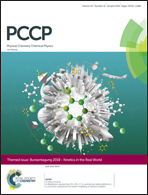Fullerene size controls the selective complexation of [11]CPP with pristine and endohedral fullerenes†
Abstract
The ability of the carbon nanoring [11]cycloparaphenylene ([11]CPP) for coordinating fullerenes has been tested using a series of hosts, including the pristine fullerenes C60, C70, C76 and C78, the clusterfullerene Sc3N@C80, monometallic endofullerenes Y@C82 and Tm@C82, and dimetallic endofullerenes Y2@C82 and Lu2@C82. A systematic theoretical study employing dispersion corrected density functional methods has been carried out in order to explore the characteristics of the complexes and the strength of the interaction. Depending on the dimer, complexation energies span from around −36 kcal mol−1 with C60 to −53 kcal mol−1 with the C82 derivatives. Dispersion is the main stabilizing contribution in these dimers, so the molecules arrange to maximize the number of close interatomic contacts. Since most fullerenes can properly fill the cavity of the nanoring the stability of the complexes is pretty similar, with the exception of the smallest fullerenes. The complexes with endohedral fullerenes show similar stabilities in all cases studied, with no noticeable dependence on the nature of the endohedral species. The results obtained suggest that fullerenes larger than C76 could be selectively encapsulated by [11]CPP compared to smaller fullerenes.
![Graphical abstract: Fullerene size controls the selective complexation of [11]CPP with pristine and endohedral fullerenes](/en/Image/Get?imageInfo.ImageType=GA&imageInfo.ImageIdentifier.ManuscriptID=C8CP00503F&imageInfo.ImageIdentifier.Year=2018)


 Please wait while we load your content...
Please wait while we load your content...